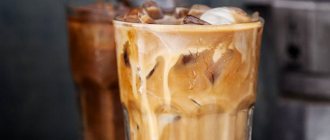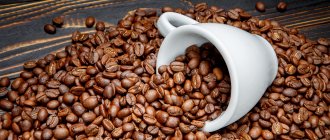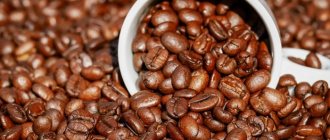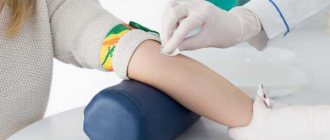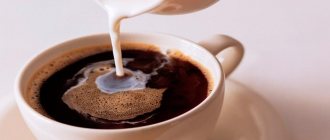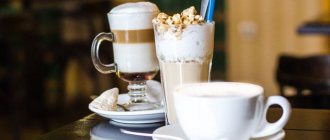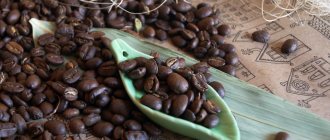How much sugar is in cola?
The high sugar content in cola - about 6 teaspoons per can - is one of the key secrets to the success of Coca-Cola and Pepsi. The second important ingredient in the composition is caffeine, which is found not only in cola, but also in drinks such as Sprite and Mirinda. However, the reason why people like to drink these drinks is not because of the sugar or caffeine content. In fact, carbonated and chilled cola does not remove thirst at all, but only provokes it.
The sugar, caffeine and mineral salts in cola provoke dehydration, causing the brain to send a signal that it needs additional fluid - and the more cola a person drinks, the more thirsty he becomes. Also, the habit of experiencing the invigorating effect of a combination of fast carbohydrates and caffeine definitely plays a role in the formation of addiction to soda.
Caffeine content in cola
Almost all carbonated drinks contain caffeine. The leader in its content is Mountain Dew. In the material about how much caffeine is in coffee, we mentioned that it contains about 50-55 mg of caffeine in a standard can (350 ml), which is comparable to a serving of espresso. Most colas (regular Coca-Cola or Pepsi, Coca-Cola Zero, Coca-Cola Light, Pepsi Zero) contain about 35-40 mg of caffeine per 350 ml (above standard can) (1).
Unfortunately, legislation in most countries does not require the exact caffeine content of carbonated drinks to be specified, so accurate information is not available to the consumer. At the same time, manufacturing companies do not provide any explanation for the presence of caffeine in drinks - it cannot affect the taste, and its presence in the composition only indicates a desire to increase dependence on cola.
Cola addiction
Scientific research shows that both children and adults are extremely sensitive to sweet tastes - essentially, they like foods that contain 25-40% sugar(2). Surprisingly, carbonated drinks have just the right level of sweetness and sugar content that people like. Apparently, this is precisely what forms the basis for the formation of addiction to cola and the habit of drinking sweet soda with every meal.
The desire of manufacturing companies to create an association between drinking cola and pleasant moments is clearly visible in advertising, when people drinking soda literally glow with joy and pleasure. For decades, the Coca-Cola Company has been actively working to create a lasting connection between the New Year's holiday and the mandatory purchase of cola.
Benefits of energy drink coffee + cola
There are several reasons to choose this option if you want to cheer up:
- It is cheap. A 0.5 bottle of cola + 2 bags of instant coffee will cost about 2-3 times less than buying a 0.5-liter can of energy drink.
- This is a relatively natural product. In any case, compared to the composition of the average ready-made energy drink, coffee and cola contain much fewer chemical ingredients, which means there are fewer risks of allergies, and the body somehow accepts this composition more easily.
- It's easy to prepare. Recipes for home energy drinks can include a variety of ingredients, from a simple tincture of Eleutherococcus, which you will have to go to the pharmacy for, to sports stimulants that are sold only in selected stores. But coffee and cola can be bought at any store or kiosk.
- This gives a quick effect. Within a few minutes you will feel a feeling of vigor, clarity of mind, and physical energy.
What is cola made from?
Typical cola ingredients include purified tap water, sugar (or sugar analogs such as high fructose corn syrup), sugar coloring, caffeine, phosphoric acid, coca extract, kola nut extract, lemon extract, vanilla, and glycerin. . Instead of sugar, Diet Coke contains sweeteners (most often, aspartame).
Classic Coca-Cola and Pepsi also contain natural flavors obtained by mixing lemon, orange and other oils. However, the exact list of ingredients from which cola is made is considered a technological secret and is not disclosed. Sometimes the press gets information that strange ingredients are found in the composition - for example, particles of insect shells used as a dark dye.
Diet Coke
It is widely known that the growth rate of soda sales in the United States is almost identical to that of the obesity epidemic(4). In other words, the more sweet cola people drink, the faster they gain weight - and the role is not played by the high calorie content of the drinks, but by the fact that the fast carbohydrates included in cola literally whet the appetite. In addition, the sugar content of cola is higher than that of most fruit juices.
In response to criticism, manufacturing companies have released diet and low-calorie versions of drinks, replacing sugar (or even more harmful fructose syrup) with sweeteners. However, growing evidence suggests that sweeteners trick the brain into craving regular sugar, resulting in extra calories from sources other than Diet Coke.
How to counteract a caffeine overdose
Excessive consumption of caffeine poses a risk of poisoning. The consequences of an overdose can be very serious. List of signs of overdose:
- impaired coordination;
- excessive overstimulation;
- visual and hearing impairment;
- nausea, vomiting;
- confusion, hallucinations;
- rapid pulse, which after a while can turn into a rare one;
- blueness of the skin;
- breathing problems, suffocation;
- sleep disturbance, irritability;
- headache;
- temperature increase.
If such symptoms are found, you should definitely call a doctor. Poisoning can be caused not only by food or drinks, but also by medications or dietary supplements. The symptoms of poisoning are identical.
If you have symptoms of a caffeine overdose, it is better to call a doctor.
Before the ambulance arrives, a person poisoned by caffeine must be given first aid:
- take the victim out into the fresh air, unfasten clothes, belts, ties, anything that may impede the access of oxygen;
- perform gastric lavage. If there is a gag reflex, it cannot be restrained. The body thus gets rid of toxins;
- create peace for the poisoned person.
Afterwards, the victim should be handed over to doctors, further actions should be carried out within the walls of a medical institution.
How much cola can you drink a day?
Average soda consumption in the United States has doubled over the past thirty years, peaking at 500 ml per person per day in the late nineties(4). Moreover, in some states the average person drank more than one liter of cola per day. At the same time, we are talking about the average figure - if you do not take into account people who do not drink soda at all, the figure will be significantly higher.
We can say with 100% confidence that daily consumption of cola in such quantities has a negative impact on health - from the destruction of tooth enamel and stomach problems to the development of obesity. Naturally, nutritionists do not give recommendations on how much cola you can drink per day, but recommend completely eliminating any type of soda from your diet.
Is Coca-Cola an evil company?
Naturally, companies such as Coca-Cola or PepsiCo do not have a stated goal in their charter to deliberately spoil people’s health and provoke mass obesity. The high sugar and caffeine content in drinks is due solely to the fact that this is the taste that people like most and this is the product they want to buy. In the end, it all comes down to maximizing profits.
Unfortunately, the main goal of these companies is based on creating loyal consumers (so-called “heavy users”) - those who drink more than two cans of cola a day. More than 80% of all soda sales come from them(3). It is also important that the formation of the habit of constantly drinking cola begins in childhood - and that is why it is better not to give it to children at all.
Sports drinks and isotonics - a new market
To boost sales, Coca-Cola partnered with McDonald's in the 1980s, making the combination of cola and fast food an industry standard. This was followed by an emphasis on small neighborhood stores - in the USA they were often bought out only in order to compete with competitor brands (2). The main priority in recent years has been sweet juice, bottled sugar tea and sports drinks.
Unlimited advertising budgets are spent on promoting the fact that athletes definitely need isotonic drinks Powerade or Gatorade - products of the same Coca-Cola Company and PepsiCo. Despite the fact that sports doctors and nutritionists constantly remind that the only difference between Powerade and cola is the taste and lack of gas, simply no one listens to them.
***
The secret to the success of cola is a composition that does not remove thirst at all, but only provokes it, forcing you to drink more. The question of whether the composition contains sugar or a sweetener plays a secondary role - ultimately, drinking any soda is incompatible with weight loss, since it almost always provokes a person to consume excess carbohydrates.
Scientific sources:
- Caffeine Chart - Center for Science in the Public Interest, source
- How The Food Industry Manipulates Taste Buds, source
- Industry Studies, Edited by Larry L. Duetsch, source
- Effects of Soft Drink Consumption on Nutrition and Health, source
The date of last update of the material is May 7, 2019
Coffee and cola recipes
Everything is simple here. Anyone can make an energy drink with coffee and cola, there are no special canons or proportions, use your own guidance or use our tips. In any case, you definitely don’t need to measure anything with scales.
Maximum effect: natural coffee with cola
Brew natural coffee in double or triple concentration, using 2 or 3 times less water than you usually pour. If you are using a coffee machine, make espresso. You can even just pour boiling water over the ground grains and let it brew for 5-7 minutes.
Refrigerate the drink, or use plenty of ice. Warm coffee with cola is not tasty.
Pour coffee into a cup and add about 250 ml of cola. Can be drunk with ice.
For extra vivacity, you can squeeze a slice of lemon into a glass.
Fast and cheap: instant coffee and cola
Buy instant coffee and cola. If conditions allow and there is a cup, pour a third of a teaspoon of coffee into the cup, carefully add cola, because it will foam. Stir with a spoon and drink. If conditions are spartan, pour the coffee directly into the bottle. Cover and stir gently with gentle movements to dissolve the coffee. Open carefully, the drink will probably splash and may foam.
Use pure instant coffee, not 3 in 1! Powdered milk with cola, of course, will keep you up all night, but it won’t be the effect you were hoping for.
The taste of the holiday: coffee, cola and cognac
It’s also a good energy drink, but if you don’t need to engage in mental work, but only require physical activity, and you don’t drive a car. Very invigorating and at the same time slightly relaxing.
Mix coffee, cola and add a couple of tablespoons of cognac (or vodka) per 0.5 liter of drink. Possible effect of slight intoxication! You will hardly be able to think productively, but you will be able to dance all night or move actively.
Use regular cola for this recipe; diet cola will make you more intoxicated!
Contraindications
This drink, despite its popularity, is not suitable for everyone. It should be avoided:
- Pregnant and lactating women (however, any energy drinks are contraindicated for them);
- Children under 14 years old;
- Persons with individual intolerance or hypersensitivity to caffeine;
- People with diseases of the cardiovascular system;
- People with kidney diseases;
- People with diseases of the nervous system.
After consumption, increased heart rate may occur. A large dose of caffeine suddenly enters the body, and it perceives it as intoxication. The following short-term effects are possible:
- Tachycardia;
- Frequent urination;
- Nausea;
- Stomach upset.
Usually all these symptoms go away within 10-20 minutes, so there is nothing to worry about. Drink water and breathe deeply, or vomit the drink if you feel very sick.
Does cocoa have caffeine?
The modern “consumer” is overwhelmed by a real barrage of information about the benefits and harms of certain food products. Responsible buyers are concerned about the chemical composition of everything that comes to their table. People have different attitudes towards caffeine. Some consider it an ordinary natural stimulant, while others fear its harmful effects on health. In any case, information about the content of this alkaloid in certain drinks is useful for people who monitor the quality of their diet. Today we will look for traces of this substance in another favorite drink of children and adults - aromatic cocoa. Does cocoa contain caffeine, and if so, in what quantities?
Harm to children
Such harmful things are always especially dangerous for children. Coca-Cola is the same case.
Firstly, due to its calorie content, it suppresses appetite, and the child will simply refuse to eat normal food if the drink is consumed excessively.
Cola negatively affects growth and bone development, promotes the formation of caries and damages tooth enamel. The caffeine in its composition has a negative effect on the children's brain. The high acidity of cola can contribute to an imbalance in the acid-base balance in a child’s body, which will lead to problems with the digestive system.
Table of caffeine content in products
All of the above data (and more) are summarized in a table for convenient calculation of the stimulant received. The table contains data on the amount of caffeine determined in laboratory conditions.
| Portion in milliliters\grams | 230 | 230 | 230 | 230 | 200 | 200 | 200 | 200 | 200 | 335 | Materials used in the article:https://kofella.net/kofe-i-zdorove/est-li-v-kakao-kofein.html https://bolit-serdce.ru/publication/sovremennyie-metodyi-lecheniya-ibs/ In Heart Treatment Add a comment Cancel reply |
